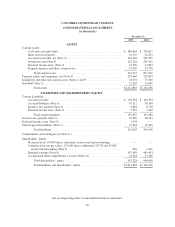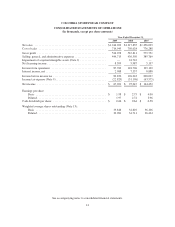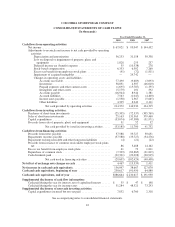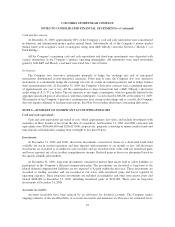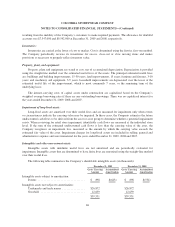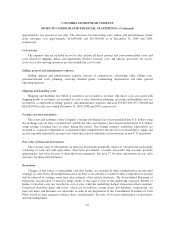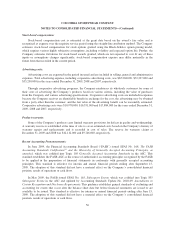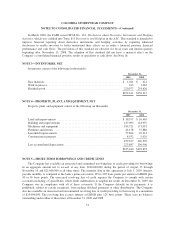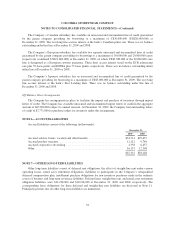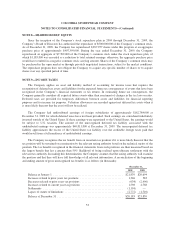Columbia Sportswear 2009 Annual Report Download - page 52
Download and view the complete annual report
Please find page 52 of the 2009 Columbia Sportswear annual report below. You can navigate through the pages in the report by either clicking on the pages listed below, or by using the keyword search tool below to find specific information within the annual report.COLUMBIA SPORTSWEAR COMPANY
NOTES TO CONSOLIDATED FINANCIAL STATEMENTS—(Continued)
Cash and Investments
At December 31, 2009, approximately 80% of the Company’s cash and cash equivalents were concentrated
in domestic and international money market mutual funds. Substantially all of the Company’s money market
mutual funds were assigned a AAA or analogous rating from S&P, Moody’s Investor Services (“Moody’s”) or
Fitch Ratings.
All the Company’s remaining cash and cash equivalents and short-term investments were deposited with
various institutions in the Company’s primary operating geographies. All institutions were rated investment
grade by both S&P and Moody’s and most were rated AA- / Aa1 or better.
Derivatives
The Company uses derivative instruments primarily to hedge the exchange rate risk of anticipated
transactions denominated in non-functional currencies. From time to time, the Company also uses derivative
instruments to economically hedge the exchange rate risk of certain investment positions and to hedge balance
sheet remeasurement risk. At December 31, 2009, the Company’s derivative contracts had a remaining maturity
of approximately one year or less. All the counterparties to these transactions had a S&P / Moody’s short-term
credit rating of A-2 / P-2 or better. The net exposure to any single counterparty, which is generally limited to the
aggregate unrealized gain of all contracts with that counterparty, was less than $1,000,000 at December 31, 2009.
The majority of the Company’s derivative counterparties have strong credit ratings and as a result, the Company
does not require collateral to facilitate transactions. See Note 16 for further disclosures concerning derivatives.
NOTE 2—SUMMARY OF SIGNIFICANT ACCOUNTING POLICIES
Cash and cash equivalents:
Cash and cash equivalents are stated at cost, which approximates fair value, and include investments with
maturities of three months or less from the date of acquisition. At December 31, 2009 and 2008, cash and cash
equivalents were $386,664,000 and $230,617,000, respectively, primarily consisting of money market funds and
time deposits with maturities ranging from overnight to less than 90 days.
Investments:
At December 31, 2009 and 2008, short-term investments consisted of shares in a short-term bond fund
available for use in current operations and time deposits with maturities of six months or less. All short-term
investments are classified as available-for-sale securities and are recorded at fair value with any unrealized gains
and losses reported, net of tax, in other comprehensive income. Realized gains or losses are determined based on
the specific identification method.
At December 31, 2009, long-term investments consisted of mutual fund shares held to offset liabilities to
participants in the Company’s deferred compensation plan. The investments are classified as long-term as the
related deferred compensation liabilities are not expected to be paid within the next year. These investments are
classified as trading securities and are recorded at fair value with unrealized gains and losses reported in
operating expenses. These long-term investments are included in intangibles and other non-current assets and
totaled $826,000 at December 31, 2009, including unrealized gains of $130,000. There were no long-term
investments at December 31, 2008.
Accounts receivable:
Accounts receivable have been reduced by an allowance for doubtful accounts. The Company makes
ongoing estimates of the uncollectibility of accounts receivable and maintains an allowance for estimated losses
45







